Sector-specific Cash and Voucher Assistance
CVA can help people in crises address their needs within a specific humanitarian sector, such as water, food, health, shelter, livelihood, or protection. Sector-specific CVA can be restricted or unrestricted, and conditional or unconditional, and will typically be provided as part of a comprehensive package which may also include in-kind and service-based assistance.
Each sector has to consider different questions, challenges, advantages and risks when it comes to supporting people’s recovery within their area of expertise. This requires evidence, tools, guidance and capacity. Meeting sector-specific outcomes through CVA also requires a multi-sectoral understanding of needs and of household economic security – see Multipurpose Cash Assistance. While some sectors are very experienced in implementing CVA and have done so for many years, others are now catching up. Most humanitarian sectors are committed and have been increasing their efforts on sector-specific CVA. The Global Cluster Coordination Group (GCCG) is also coordinating cross-cluster work to improve the sectoral used of CVA.
Current priorities
The CALP Network works closely with the cash technical groups/task teams within the global clusters, who have been defining their 2020 priorities and workplans during their regular meetings. A general overview and specific details of these priorities across each global cluster is available here.
Sector-specific CVA subpages
Camp Coordination, Camp Management and Cash and Voucher Assistance
Page
Find out more about Camp Coordination and Camp Management (CCCM) in relation to Cash and Voucher Assistance (CVA). For the most up to date information visit the Global CCCM Cluster’s website.
Education and Cash and Voucher Assistance
Page
A brief introduction as to how Cash and Voucher Assistance (CVA) can support education outcomes. For the most up to date information please visit the Global Education Cluster’s website.
Food Security and Cash and Voucher Assistance
Page
A brief introduction as to how Cash and Voucher Assistance (CVA) can support food security outcomes. For the most up to date information please visit the Food Security Cluster Cash and Market Working Group web page.
Health and Cash and Voucher Assistance
Page
The content on this webpage has been developed with the Global Health Cluster.
Nutrition and Cash and Voucher Assistance
Page
Malnutrition continues to pose a major challenge to human well-being around the world. In 2020, an estimated 144 million children under five suffer from stunting (i.e. chronic malnutrition) , 47 million children under five were wasted (i.e. acute malnutrition) , of which 14.3 million were severely wasted, and an additional 340 million suffered from micronutrient deficiencies (UNICEF/WHO/WB...
Protection and Cash and Voucher Assistance
Page
How can Cash and Voucher Assistance (CVA) support protection outcomes? Please find a brief summary below, and for the very latest information, refer to the Global Protection Cluster Task Team on Cash for Protection.
Shelter and Cash and Voucher Assistance
Page
How can Cash and Voucher Assistance (CVA) support shelter outcomes? Please find a brief summary below, and for the very latest information, refer to the Shelter and Cash Working Group.
WASH and Cash and Voucher Assistance
Page
How can Cash and Voucher Assistance (CVA) support WASH outcomes? Please find a brief summary below, and for the very latest information, refer to the WASH Cluster’s Cash and Markets Technical Working Group.
Latest

Cash and Voucher Assistance for Education in Emergencies. Synthesis Report and Guidelines
Report
The Global Education Cluster (GEC) developed in 2018-19 the Synthesis and Guidelines on Cash and Voucher Assistance for Education in Emergencies (EiE). The document was developed with financial support from ECHO and technical support from CashCap. The research focused on current CVA practices for...
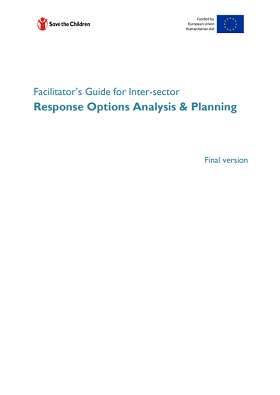
Response Options Analysis Planning Guide
Guidelines and Tools
The inter-sector Response Options Analysis and Planning (ROAP) is a structured decision-making process, which draws from the information generated through a multitude of needs and operational environment assessments. The ROAP gives way to the selection of the most appropriate, operationally feasible and...

Cash for Shelter in Kenya – A Field Experience
Report
A study of a cash for shelter project in Kalobeyei that highlights how UNHCR uses cash assistance to help the refugees to transition to more durable solutions, in this case, integration with the host community. The project presents a paradigm shift from the traditional refugee camp planning process.

Elevating Education in Emergencies
Report
The overall purpose of the Elevating Education in Emergencies series is to galvanise increased attention for and prioritisation of education in humanitarian responses. Following the first session which explored education’s critical role in bringing protection to children, youth and
communities affected...

Protecting Nutrition of Pregnant and Lactating Women and Children in Acute Food Crises
Report
This briefing sheet provides an overview of methods and findings from a study examing the impact of cash and voucher assistance on prevention of acute malnutrition among pregnant and lactating women and children in the context of the 2017/18 Somalia food crisis. Changes in diet and acute malnutrition were...
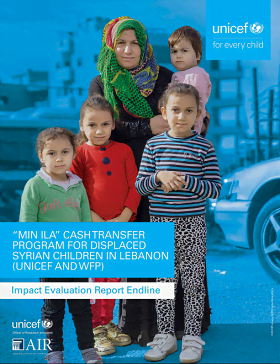
“Min Ila” cash transfer program for displaced Syrian children in Lebanon
Report
“Min Ila” is a cash transfer program that was implemented by UNICEF and the United Nation’s World Food Program (WFP) in coordination with the Ministry of Education and Higher Education (MEHE), between 2016 and 2018 covering two (and later three) Lebanese governorates. The program, also known as...

Micro-level changes in market recovery and growth: The Ebola CTP experience
Webinar recording
Following our Ebola dissemination event in Dakar, the CALP Network hosted a webinar looking at the micro level effects of cash transfers on local economies during the Ebola crisis. Listen to the recording here.
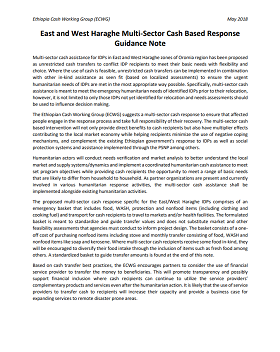
East and West Haraghe Multi-Sector Cash Based Response Guidance Note
Guidelines and Tools
Multi-sector cash assistance for IDPs in East and West Haraghe zones of Oromia region has been proposed as unrestricted cash transfers to conflict IDP recipients to meet their basic needs with flexibility and choice. Where the use of cash is feasible, unrestricted cash transfers can be implemented in...

Understanding Market Drivers in Syria
Report
Study conducted by the SIM Consortium (Syria Independent Monitoring) in partnership with iMMAP, commissioned by DFID (report initially released in January 2018). This report documents the findings of an in-depth assessment of the olive/olive oil and spice/herb market systems in northeastern and...
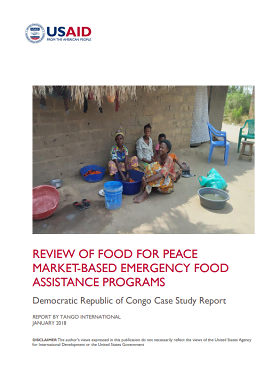
Review of Food for Peace Market-Based Emergency Food Assistance Programs: Democratic Republic of Congo Case Study Report
Report
The Democratic Republic of Congo (DRC) case illustrates the complexity and diversity of contexts within which program design and implementation occurs. It highlights the need for provincial-scale assessments, local market monitoring, and flexibility to pivot to different modalities depending on changing...
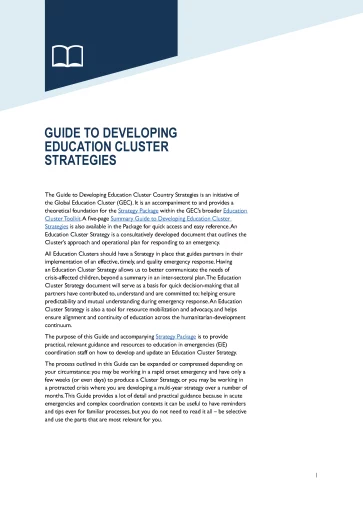
Guide to Developing Education Cluster Strategies
Guidelines and Tools
All Education Clusters should have a Strategy in place that guides partners in their implementation of an effective, timely, and quality emergency response. Having an Education Cluster Strategy allows us to better communicate the needs of crisis-affected children, beyond a summary in an inter-sectoral...
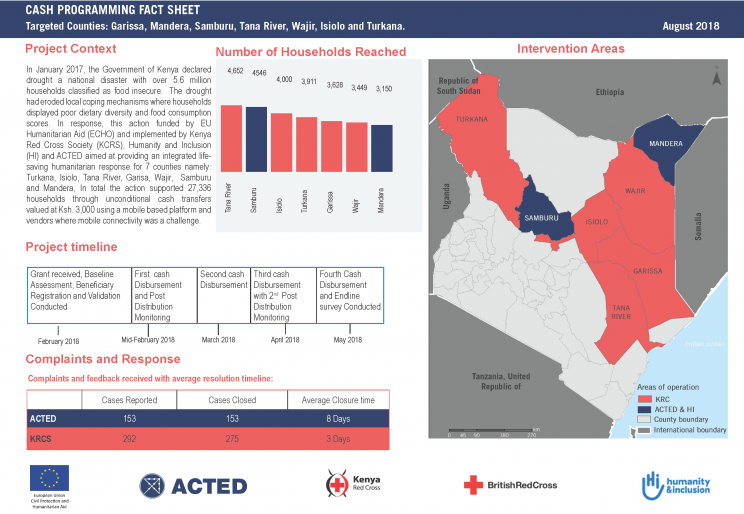
Cash Programming Fact Sheet
Report
A cash programming fact sheet demonstrating cash intervention in Kenya funded by EU Humanitarian Aid (ECHO). The program objective was to increase access to humanitarian assistance for vulnerable and drought-affected populations in the ASAL counties of Kenya.
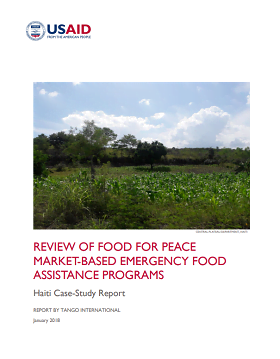
Review of Food for Peace Market-Based Emergency Food Assistance Programs: Haiti Case-Study Report
Report
Haiti is a very low-income country with a degraded ecological setting that faces repeated threats from multiple hazards. It is an excellent example of Food for Peace (FFP) linking emergency and development funding through the Kore Lavi Title II program that serves as a model for the national social...

Addressing food insecurity: Does the choice of transfer modality matter?
Report
This operational study analyses the impact of multipurpose cash (MPC)—associated with a nutrition-sensitive training—on the food security and nutrition of the households affected by the drought in the Salvadoran Dry Corridor. Three quantitative and qualitative surveys—with a strong gender...
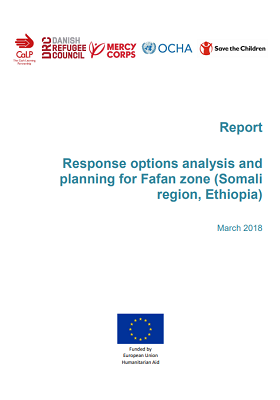
Response options analysis and planning for Fafan zone (Somali region, Ethiopia)
Guidelines and Tools
Between October 2017 and March 2018, the Consortium began the pilot in Ethiopia with the aim of providing technical and strategic support to country-based humanitarian organisations, enabling them to engage in collaborative assessments and decision making. Whilst the Consortium has not been conceived to...

The Role of Cash Transfers in Social Protection, Humanitarian Response and Shock-Responsive Social Protection
Guidelines and Tools
Cash transfers have expanded rapidly in low- and middle-income countries (LMICs) around the world in the past decade. The contexts in which they are implemented have also diversified; while cash transfers were mostly adopted initially as central elements of social protection systems, they have become...
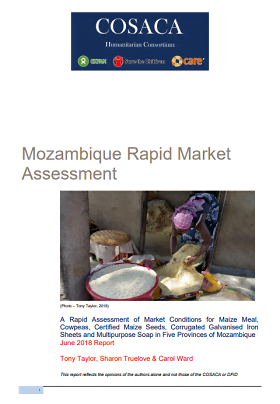
Mozambique Rapid Market Assessment
Report
Mozambique is a country prone to natural disasters, most markedly floods, cyclones, pest and disease outbreaks and frequent droughts. These regularly exacerbate the underlying poverty and food security situation and cause major damage and set back economic growth in disaster-affected areas. Meteorological...

The 1.5 Billion People Question : Food, Vouchers, or Cash Transfers?
Report
Most of the people in low and middle-income countries covered by social protection receive assistance in the form of in-kind food. The origin of such support is rooted in countries’ historical pursuit of three interconnected objectives, namely attaining self-sufficiency in food, managing domestic food...

E-Transfer implementation guide
Guidelines and Tools
This updated E-transfer Implementation Guide replaces the original guide published in 2014. In cash transfer programming (CTP), electronic transfers (e-transfers) are a digital replacement for paper vouchers or physical cash. E-transfers are a disbursement mechanism – a way of transferring money, goods...
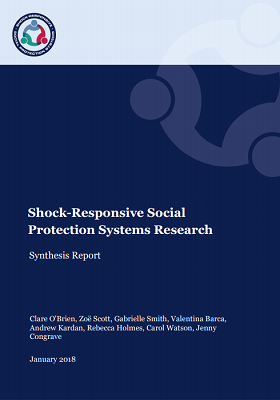
Shock Responsive Social Protection Systems Research: Synthesis Report
Report
This synthesis report consolidates the evidence and lessons learned from the research, drawing on all the case studies and other outputs, including the literature review as well as policy briefs on systems development and monitoring and evaluation. It highlights the key ways in which social protection...